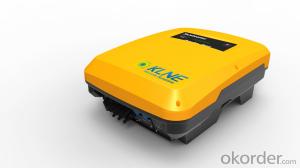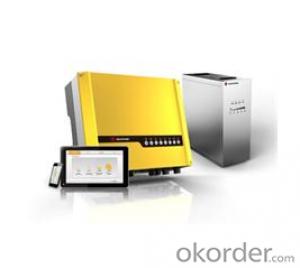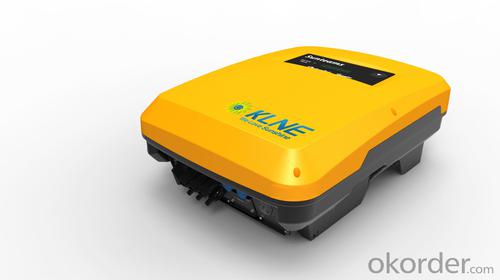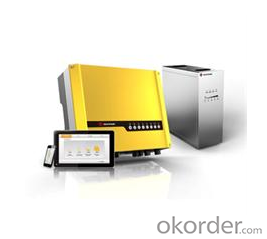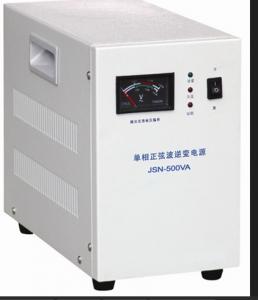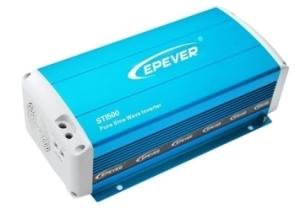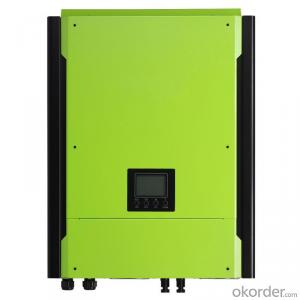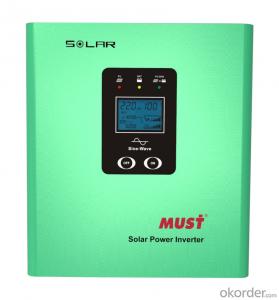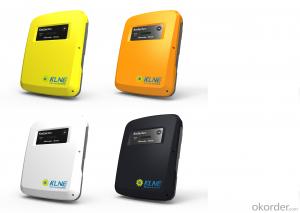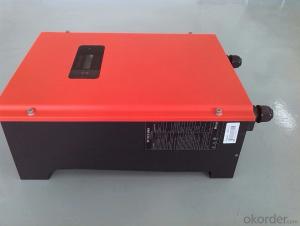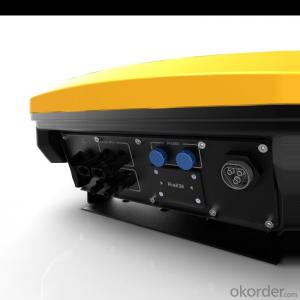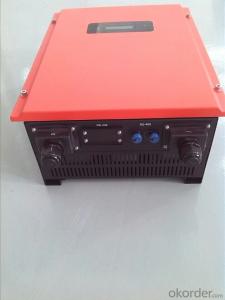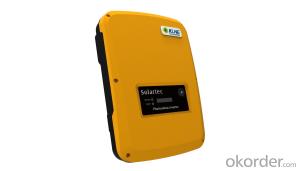40 Kw Solar Inverter Off Grid Type Solo-5000 Series
- Loading Port:
- Shanghai
- Payment Terms:
- TT OR LC
- Min Order Qty:
- 10 unit
- Supply Capability:
- 1000 unit/month
OKorder Service Pledge
OKorder Financial Service
You Might Also Like
Product Description:
This system can keep 10 energy-saving bulbs with 15W working for 5 hours per day and a 5W radio working for 8 hours a day. The AC load can keep a 33in color TV (90W) working for 5 hours, a 70W phonograph record machine working for 5 hours, a 200L fridge (180W) working a whole day, a fan less than 60W running for 5 hours, a 300W computer working for 4 hours, two 100W laptops working for 5 hours, a 1000W water heater running for 1 hour, and another 500W appliance running for 3 h.
It can work for 3 successive rainy days.
● System voltage: 110V
● Output: 220VAC/50Hz
● Power: 5000VA
● Dimensions of the box: 600 X 2000 X 600mm
● Net weight: 255kg
Product Datasheet:
Main Accessories | Specifications | No. | Notes |
Inverter | Solo-5000 | 1 | Standard |
PV modules | Polysilicon 85Wp | 40 pieces | Optional |
Storage battery | Lead acid, maintenance-free, 2V/450Ah | 55 pieces | Optional |
Controller | Solo-VS110V/50A | 1 unit | Optional |
PV accessories shelf | Customized | 1 set | Optiona |
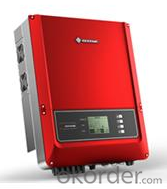
Product Advantages:
Powered by DC current
Can used out of doors
High effiency and low noise
FAQ
What is your payment terms?
We accept T/T payment, normally we need 20% T/T in advance, 80% payed before shipment.
What is your packing system?
We put the sistem in the wooden box.
Can you do OEM service?
Yes we can, but we need to do it with a certain order quantity.
- Q: Can a solar inverter be used in grid-tied systems?
- Yes, a solar inverter can be used in grid-tied systems. In fact, a solar inverter is an essential component of a grid-tied system as it converts the direct current (DC) produced by the solar panels into alternating current (AC) that can be fed into the electrical grid. This allows for the efficient utilization of solar energy and enables homeowners or businesses to offset their electricity consumption with solar power, potentially even earning credits for excess energy produced.
- Q: What is the role of a solar inverter in preventing system failures?
- The role of a solar inverter in preventing system failures is to convert the direct current (DC) produced by solar panels into alternating current (AC) that can be used to power electrical devices. By continuously monitoring the performance of the solar system and ensuring the optimal conversion of power, the inverter helps to prevent issues such as voltage fluctuations, overloading, and short circuits. It also provides vital protection by promptly detecting and responding to any faults or abnormalities in the system, thereby minimizing the risk of system failures and maximizing the overall efficiency and reliability of the solar power generation.
- Q: How does a solar inverter handle voltage harmonics?
- A solar inverter handles voltage harmonics by using filtering techniques and advanced control algorithms. These methods help to smooth out the output voltage waveform, reducing or eliminating any unwanted harmonics.
- Q: Can a solar inverter be used in areas with high altitude and low temperature conditions?
- Yes, a solar inverter can be used in areas with high altitude and low temperature conditions. However, it is important to consider certain factors when selecting a solar inverter for such conditions. High altitude can affect the efficiency of the solar inverter due to reduced air density and oxygen levels. This can lead to a decrease in the power output of the solar panels. Therefore, it is crucial to choose an inverter that is specifically designed to work at high altitudes. These inverters are equipped with features such as advanced cooling systems and improved power electronics to ensure optimal performance in such conditions. Low temperature conditions can also impact the efficiency of a solar inverter. Cold temperatures can affect the inverter's internal components and reduce its overall performance. To overcome this, it is recommended to select an inverter that is designed to operate in low-temperature environments. These inverters are typically equipped with features such as internal heaters and temperature sensors to maintain optimal performance even in freezing temperatures. Additionally, it is advisable to consult with a professional solar installer or manufacturer who can provide guidance on the most suitable solar inverter for high altitude and low-temperature conditions. They can consider factors such as local climate, altitude, and specific installation requirements to ensure the system is designed to withstand and perform optimally in these challenging conditions.
- Q: What is the role of reactive power injection in a solar inverter?
- The role of reactive power injection in a solar inverter is to help maintain the stability and quality of the electrical grid. Reactive power is required to regulate voltage levels and compensate for any imbalances or fluctuations in the grid. By injecting reactive power, a solar inverter can ensure that the power generated from the solar panels is in sync with the grid's voltage and frequency, helping to maintain proper power flow and prevent potential issues such as voltage sags or surges.
- Q: What are the potential risks of over-discharging a battery connected to a solar inverter?
- The potential risks of over-discharging a battery connected to a solar inverter include reduced battery lifespan, decreased storage capacity, increased internal resistance, and potential damage to the battery cells. Over-discharging can lead to deep cycling, which can degrade the battery's performance and shorten its overall lifespan. It may also cause the battery to lose its ability to store energy efficiently, resulting in reduced storage capacity. Additionally, over-discharging can increase the internal resistance of the battery, leading to decreased efficiency and lower power output. In severe cases, over-discharging can cause irreversible damage to the battery cells, rendering them unusable and necessitating replacement.
- Q: Can a solar inverter be used in a mobile or portable solar system?
- Yes, a solar inverter can be used in a mobile or portable solar system. In fact, portable solar systems often include solar inverters to convert the direct current (DC) power generated by solar panels into alternating current (AC) power that can be used to run electrical devices or charge batteries. This allows for the convenience of using solar energy on the go, making it ideal for camping, outdoor activities, and emergency power needs.
- Q: Can a solar inverter be used with a hybrid solar power system?
- Yes, a solar inverter can be used with a hybrid solar power system. A hybrid solar power system combines solar energy with other sources such as batteries or the electrical grid. The solar inverter is responsible for converting the direct current (DC) generated by the solar panels into alternating current (AC) that can be used to power household appliances or fed back into the grid. It plays a crucial role in ensuring the compatibility and efficient operation of the hybrid solar power system.
- Q: What are the advantages of using a solar inverter with battery storage?
- There are several advantages of using a solar inverter with battery storage. Firstly, it enables the storage of excess solar energy generated during the day, which can be utilized during the night or during periods of low solar generation. This allows for greater self-consumption of solar energy and reduces reliance on the grid, resulting in potential cost savings on electricity bills. Additionally, solar inverters with battery storage provide backup power during power outages. The stored energy in the batteries can be used to power essential appliances and devices, ensuring uninterrupted electricity supply. Furthermore, using a solar inverter with battery storage promotes energy independence and sustainability. By storing and using solar energy, individuals can reduce their carbon footprint and contribute to a cleaner environment. It also provides flexibility in energy management, as users can choose when to draw energy from the grid or from the batteries, depending on the energy rates or their specific needs. Overall, integrating battery storage with a solar inverter offers increased energy efficiency, cost savings, backup power, and environmental benefits, making it a compelling solution for residential and commercial solar installations.
- Q: Can a solar inverter be used with micro-inverters?
- Yes, a solar inverter can be used with micro-inverters. Micro-inverters are typically used in small-scale solar installations to optimize the performance of individual solar panels. They convert the DC power generated by each solar panel into AC power, which can then be combined and synchronized by a central solar inverter. This allows for greater flexibility, efficiency, and monitoring capabilities in the overall solar system.
Send your message to us
40 Kw Solar Inverter Off Grid Type Solo-5000 Series
- Loading Port:
- Shanghai
- Payment Terms:
- TT OR LC
- Min Order Qty:
- 10 unit
- Supply Capability:
- 1000 unit/month
OKorder Service Pledge
OKorder Financial Service
Similar products
Hot products
Hot Searches
Related keywords
